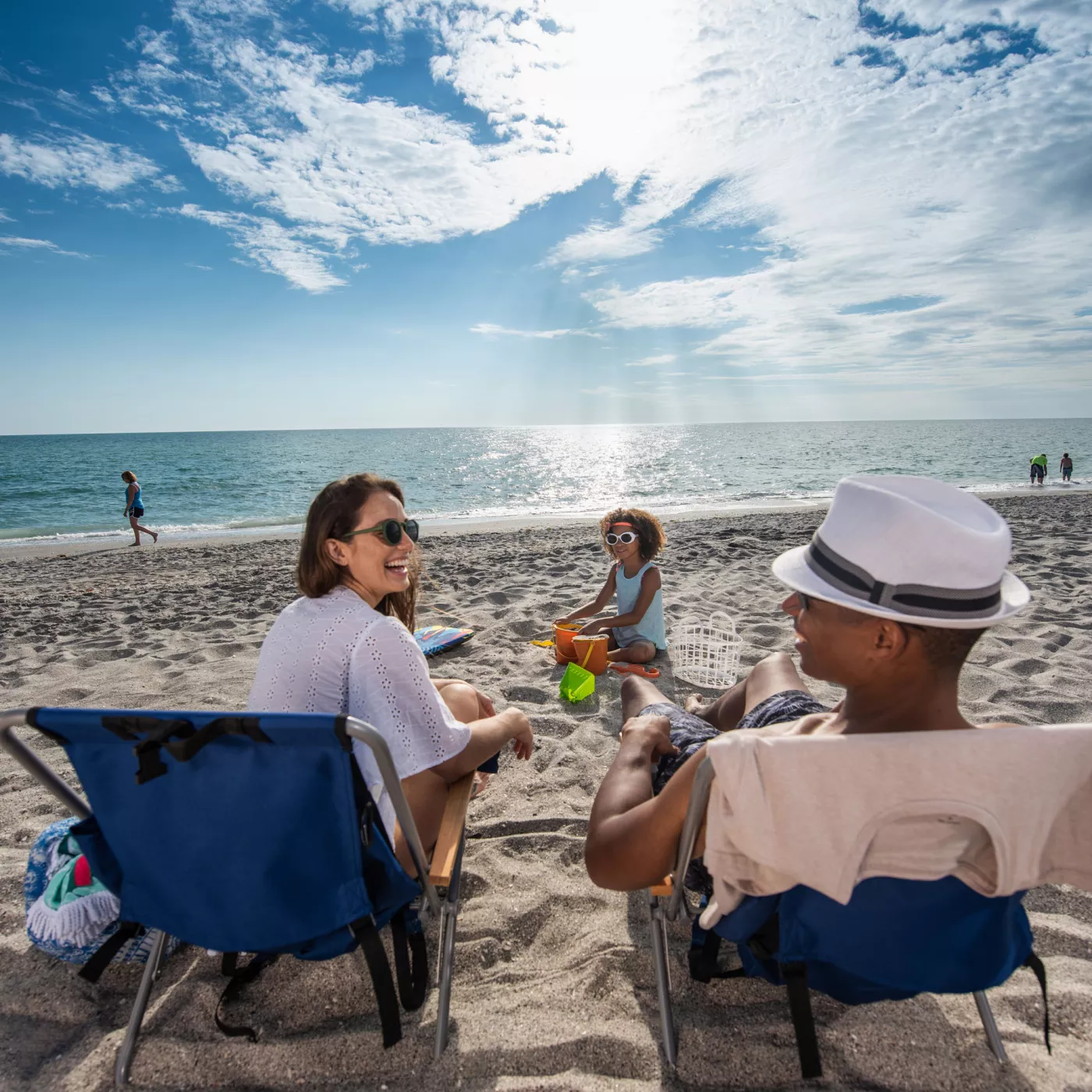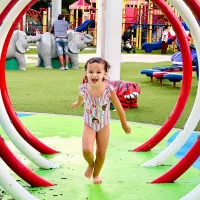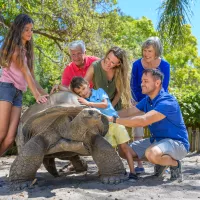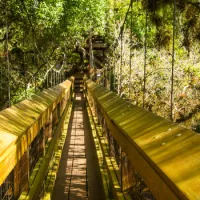What is that? Sarasota Animal ID
Learn about the local and unique Florida wildlife that exists in Sarasota County and have made this sub-tropical environment their home.
Learn about the local and unique Florida wildlife that exists in Sarasota County and have made this sub-tropical environment their home.
Sarasota abounds with wildlife, both big and small, on the land, in the sea, and in the sky. Many are unique to the region and, while enjoying Sarasota, various critters may cross your path that make you wonder “What did I just see?” Here are your answers for many of the common, misunderstood, or unusual of the Floridian faunae.
Ibis
What it looks like: White bird, similar in size to a chicken, with a long curved pink beak. Usually seen walking in groups.
What it does: These gangs of avian friends meander the neighborhoods, using their long beaks to dig out bugs and small sea creatures. Dozens will work together to nosh on a yard before walking to the adjacent lawn. When they fly away in unison, it’s a grand sight.
Manatee
What it looks like: A large, grey blob, swimming slowly in the water. They are typically witnessed in shallow, warm waters and will pop their nostrils out of the water to breathe.
What it does: Enjoys the slow life of swimming and grazing on aquatic vegetation. No need to fear these friendly manatees, but boats must remain cautious as they are slow and easily injured.
Cormorant / Anhinga
What they look like: Almost identical. These sleek black water birds can be most easily differentiated by looking at their beaks. Cormorants will have curved beaks and their feathers are a deeper black. Anghingas have straight beaks and slightly lighter plumage.
What they do: Both cormorants and anhingas dive in the waters in search of fish. When they swim, only their necks and heads are visible and resemble a snake. Because they don’t have oil on their feathers, they are great divers but also need to air our their wings. They will often be seen sitting in branches, sea sides, or pilings with their wings outstretched to dry.
Mullet
What it looks like: An unassuming silver-grey fish, typically a foot long, with a rounded snout.
What they do: These fish will leap out of the water up to five times in a row. In the sea, groups swim together, often in a follow-the-leader formation, and frequent shallow water so they are easily spotted, often at the beach. Don’t bother casting their way – mullet are vegetarians and can be caught only with a net or a gigging pole. Typically eaten smoked.
Black Racer
What it looks like: A long black snake. An adult can reach a maximum length of 5 to 6 feet.
What they do: Often found in residential lawns, black racers slither quickly to avoid human contact. Searching for small critters to eat, they will pop their heads up from the long Florida grass in a manner similar to a Muppet. Black racers are not venomous.
Herons
What they look like: Sarasota boasts a variety of herons, each with a similar build – sleek body, long legs, and pointy beak. Great blue herons are the tallest and feature grey plumage with black accents. Little blue herons look like the baby of a great blue, but are a different species. Snowy egrets boast white feathers and dark bills. Great egrets have a similar stature to snowy egrets, but a thicker and darker bill. And great white herons have the thickest bill of the large white birds and may have flesh-colored legs.
Sarasota also serves as the home for the smaller tri-colored herons (grey, white, and brown feathers) and black-crowned night herons (grey feathers and a black and white striped head).
What they do: Herons reside near water and search for lizards, small fish, frogs, small animals, and insects to eat. Watch as they slowly stalk their prey, often with a wobbling neck maneuver. Most herons are solitary creatures.
Roseate Spoonbill
What it looks like: A chicken-sized pink bird with a grey spoon shaped bill.
What it does: Usually found alone or joining a group of ibis, the roseate spoonbill feasts from the water and makes an impressive sight as its pink plumage flies through the sky.
What it isn’t: A flamingo.
Bobcat
What it looks like: A spotted feline, similar in size to my schnauzer. Its fur is light brown with dark spots and its tail is short (hence its name).
What it does: The elusive bobcat stalks its prey of small mammals in the rural and forest areas of Sarasota County.
What it isn’t: A Florida Panther, also called a puma, mountain lion, or cougar. Panthers are taller, about the height of a Newfoundland, and solid tan in color. An endangered species, Florida Panthers was once common in the area, but now a sighting is extremely rare, if not impossible.
Stingray
What it looks like: Be it the Southern Stingray or the Cownose Ray, stingrays camouflage themselves in the sand with their smooth, flat, grey-brown skin. Their shape resembles Home Plate and their eyes are at the top of their bodies and their mouths and gills are located on the bottom. Their long tails are not dangerous, but the venomous barbs attached are used in self-defense and sting their danger away.
What it does: Stingrays linger on the ocean bottom to find their food. When they swim, their movement looks like flying, their fins resembling wings. Often the tips of these pectoral fins will pop out of the surface of the water and look like small dorsal fins. Like sharks, sting rays are made of cartilage. Stingrays only sting to protect themselves; to avoid an injury, use the Stingray Shuffle when you are in the water – shuffle your feet along the sandy bottom to create vibrations the rays sensor and give them time to flee. Stingrays will often migrate in groups; watching them fly through the ocean is a magnificent sight. Visitors may touch stingrays with their barbs removed at Mote Marine Aquarium.
Alligators
What they look like: Alligators are crocodilians and, as such, have bodies covered in bony scales called scutes. Their tails are long and propel them as they swim.
What they do: Florida is the only place on earth that features both alligators and crocodiles living together in the wild. However, only alligators reside in Sarasota. Found in fresh water, alligators linger quietly in the water, usually with only their eyes and nostrils visible. They often bask on the water’s edge to increase their cold-blooded body temperature. While attacks are rare, it’s a safe rule of thumb to assume any freshwater body of water in Sarasota – a pond, a lake, even a swimming pool – is the potential home of a crocodilian.
What it isn’t: A crocodile. Crocodiles live in salt water, south of Sarasota. While the body is similar to an alligator’s, alligators feature a wider snout than the crocodile as well as bolder coloring. If you happen to be close enough to view the animal’s teeth, you’d notice that the alligator’s lower teeth are not visible when its mouth is shut, while the crocodile’s bottom choppers are visible.
Turtle
What they look like: All turtles have shells and feature similar coloring. Sarasota serves as home for five species of large sea turtles – Loggerhead, Kemp’s-Ridley, Hawksbill, Green, and Leatherback, which you’ll find slowly swimming in the Bay and Gulf. Freshwater won’t boast these, but rather the prehistoric-looking alligator snapping turtle. In yards, crossing the street, and in shallow waters, the Florida softshell turtle tends to shock with its long (quite unattractive) snake-like neck and head. Common painted turtle and gopher tortoises also call Sarasota their home.
What they do: Sea turtles tend to arouse surprise and awe as they slowly traverse the water’s currents, usually alone. Kids tend to think immediately of Crush from Finding Nemo. During nesting season (May through October), sea turtles will lay their eggs along the beaches’ edges. Beachgoers will see them marked on the sand with stakes and ribbon as they must be left in peace. Alligator snapping turtles sit and wiggle their tongues to ask as lures for their prey. Softshell turtles lollygag the day away and are often found in residential areas; best to avoid them and not try to ‘help’ them across the street or into the water. They never seem to like that.
Anole
What they look like: Lizards, green or brown in color, spanning from tiny one-inch babies to adults the length of my hand. The males have a red or orange flap of skin called a dewlap that they can spread out.
What they do: Anoles frequent backyards, fences, cars, yards, houses, anywhere where they can grab some bugs to much on. They are able to detach their tails when attacked; the tail continues to squiggle as a distraction to the predator while the lizard flees. It then regrows the tail.
What it isn’t: A gecko. While geckos are found in Sarasota, they are not as commonly seen as the anole. Geckos prefer to hide and can use their bulbous suction-cup fingers to climb walls, glass, even ceilings. When they walk, they remain close to the surface they’re on and move using a squiggling motion.
Osprey
What they look like: Between the size of a hawk and an eagle, this bird of prey boasts dark brown feathers on its wings and back and white plumage on its head and stomach. A dark stripe resembles a superhero mask.
What they do: An osprey diving for fish is an impressive sight. First, they stalk from above, then dive down and capture the fish in their talons, returning to land to enjoy the feast. Their large nests are often spotting at the top of fishing pilings and telephone poles.
Spiny Orb Weaver
What they look like: Tiny, fingernail-sized spiders that appear to be wearing a spiky backpack, either in yellow, black, and white or red, black, and white. Their legs are barely visible.
What they do: My favorite spider, they make impressive webs amongst trees and gardens. They are rarely seen indoors and are not venomous.
Wild Parrots
What they look like: A flock of green dove-size birds, generally in groups between ten and twenty, though more or less is possible.
What they do: Besides confuse people? They generally squawk from their trees or telephone wires and fly in unison to their next destination. Many seen in the Marina Jacks area of downtown Sarasota. Wild parrots most likely resulted from storm displacement or irresponsible pet release.
Be sure to share your discoveries using hashtag #MySarasota. If you find a critter and are curious about what you’re seeing, post to our Facebook page or Twitter @Visit Sarasota for a little local expertise.

![Boat parking at The Crow’s Nest in Venice [Photo: Lauren Jackson]](/sites/default/files/styles/popular_stories_teaser/public/2023-import/The-Crow%2527s-Nest-cropped__OPT.jpg.webp?itok=ycs37M-O)


